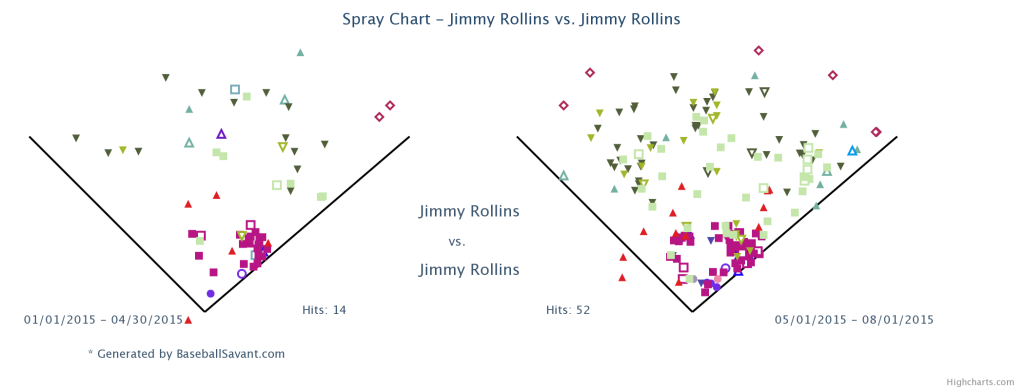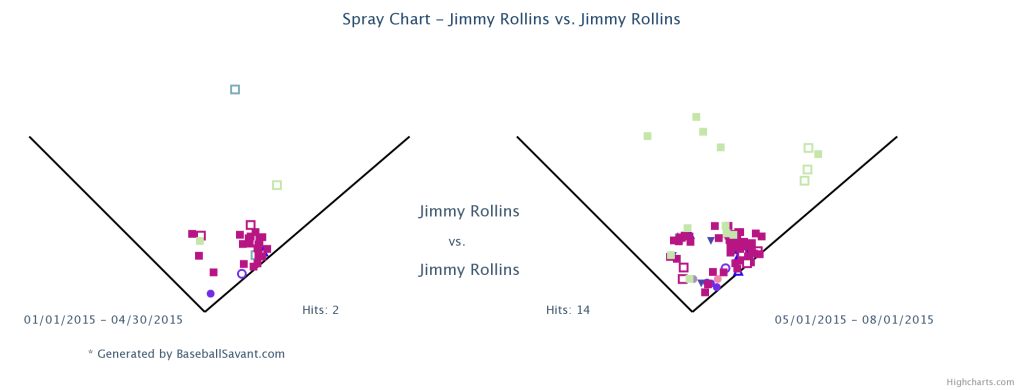When I wrote about Jimmy Rollins‘ struggles a couple months ago, I mentioned that part of the reason to worry about his production at the plate was that his seemingly “bad luck” BABIP may actually not rebound as much as expected, with one of the main factors being that he had become increasingly predictable in hitting slow choppers to the right side. Sure enough, his BABIP is currently sitting at a horrible .230, and he projects to finish with a career-low BABIP in the .250 range — and that’s if you’re feeling generous.
To the credit of Rollins, however, he has taken to trying to change his luck and find ways to be productive against the grain of obvious age skills decline, according to an article from Bill Plunkett of the OC Register.
When the switch-hitting Rollins batted from the left side, teams were starting to play defensive shifts against him. His offensive game had become so impotent and predictable that opposing teams loaded the right side of the field, confident that a ground ball or pop up would find a glove.
“I might have seen them once or twice last year. But not like this,” the veteran Rollins said. “My strong side has always been my pull side. But it just hadn’t been working. You put the shifts on top of that – it makes it a lot more difficult to hit the ball in an open area with a whole bunch of people standing over there.”
Shifts were recognized as a factor relatively early, and it was also important to note that Rollins basically admitted that “it wasn’t working” and he was a diminished player (which does sort of fit the trend), so that made him more receptive to adjustments.
Dodgers hitting coaches Mark McGwire and John Valentin saw the same thing those opposing teams were seeing. They laid the numbers out for Rollins, explaining the adjustments he could – and should – make to start hitting the ball the other way more often and how Dodger Stadium would not reward him for pulling the ball the way his former home, Citizens Bank Park in Philadelphia, had.
“We’ve gone over it in our clubhouse, ‘Whether you believe it or not this is what the numbers show and you can look at it,’” Rollins said. “I know every other team has the same metric system so they see something. I’m not going to be that dumb to keep hitting into it.”
So credit to Rollins for being open to changes, and credit the hitting coaches for recognizing a problem and trying to address it. But what about the results?
Well, the article says two months is when it started, but it was really after a month when a notable shift could be seen in how Rollins has been hitting the ball. Or, more specifically, where he has been hitting the ball.
Whether in the air or on the ground, Rollins has clearly been trying to spray the ball to all fields with more consistency of late (the raw pull percentage totals back this). That (and regression) has seemingly paid off bit by bit, with his BABIP increasing from .206 in April to .229/.238 in May and June, to finally .258 in July. Unfortunately, the rising hit rates had been rewarded with increasingly terrible performances in May and June, with Rollins putting up wRC+ of 69 and 55, respectively. Things weren’t looking good for the adjustments because, while he was getting more hits, the power had completely disappeared.
That has changed so far in July, with Rollins putting up a 104 wRC+, and managing to balance pulling the ball with authority and hitting enough balls (on the ground) the other way to get cheap hits. Perhaps most importantly to this temporary turnaround, Rollins has struck out only 8.1% of the time this month compared to 18.3% in April, thus putting himself in more situations where he can succeed.
Of course, this has transpired over only a half month, so all the appropriate caveats apply here, and I do find it highly unlikely that Rollins will continue to be above league-average offensively at his age after languishing so bad for so long. But while the .400+ SLG may not last, it’s entirely possible that the BABIP could lead to averages of .240-.250 instead of .210-.220 going forward. Paired with average defense and the atrocious league-average production from shortstops this year, and that’s not the worst scenario for a Dodgers team that just needs him to be a fringe-average regular.
Wishful thinking? Absolutely. But the adjustments give hope that there’s something to look forward to at shortstop other than Corey Seager.
 Dodgers Digest Los Angeles Dodgers Baseball Blog
Dodgers Digest Los Angeles Dodgers Baseball Blog

